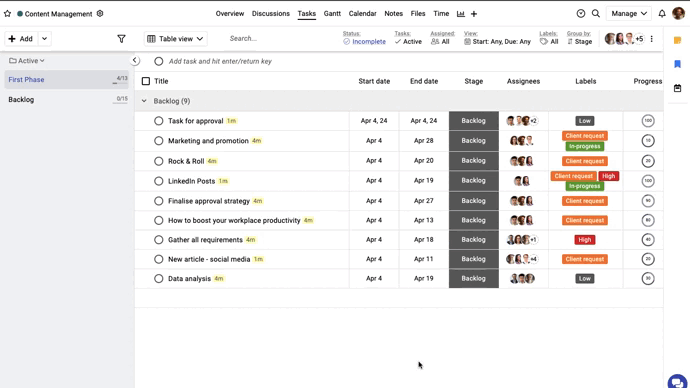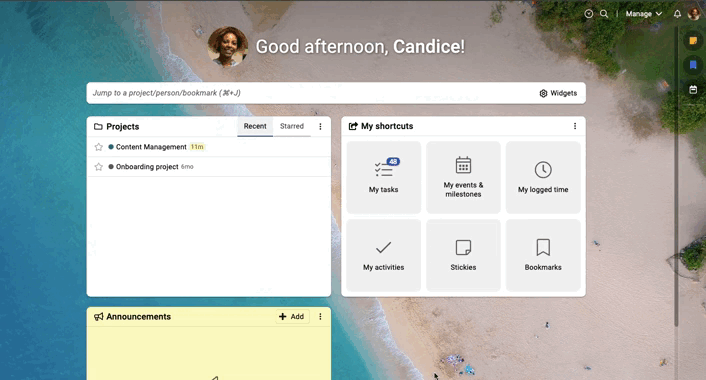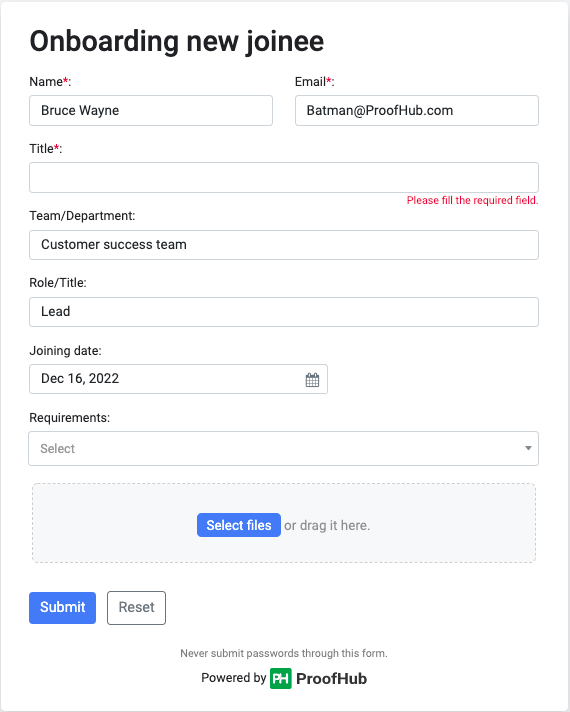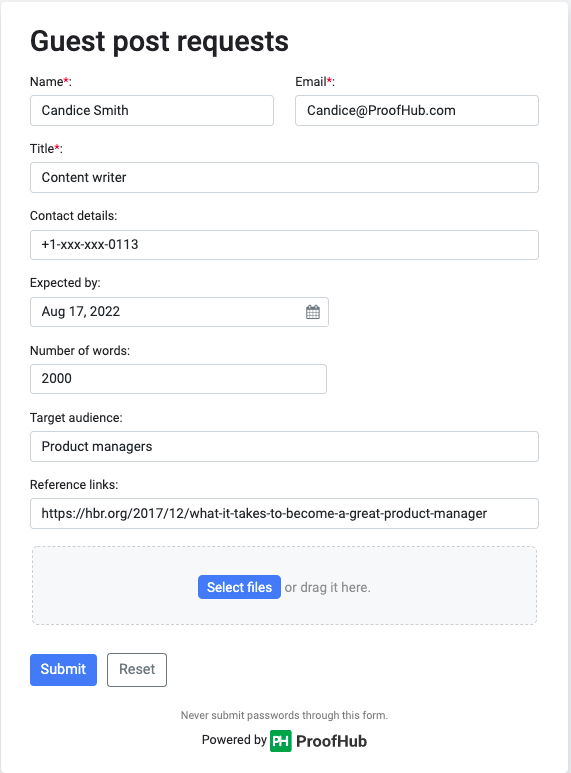Project managers are expected to wear multiple hats and be jack-of-all-trades. They are required to manage everyday work, assign tasks, and handle client needs.
A good team leader is capable of efficiently handling incoming work requests. To effectively manage a project, the project manager must be able to prioritise work as it comes in.
It takes a lot of effort to process, prioritize, and track incoming work requests. However, ProofHub helps teams streamline incoming work requests with the help of its comprehensive Forms.
Table of Contents
What are Forms in ProofHub?
Forms in ProofHub allow you to collect requests from both internal and external users. Forms aid in creating a clear communication channel between teams, external clients, and stakeholders. Requests are automatically added as tasks to the project’s designated tasklist.
ProofHub recognises how quickly your inbox may fill up with requests for work, tickets, and even support questions. In all that chaos, you can miss a necessity.
ProofHub now allows you to build request forms and accept work requests. The data you enter in the form will be saved as a task in your choice’s project and task list. For example, you can keep all of your customer support requests in a specific project, and task list and your design, marketing, and other requests can be stored separately.
Custom fields can be enabled in forms and are often used to collect additional information about a product or service. End-users will have access to these fields and will be able to fill in the necessary information.
How to add a Form?
Forms can be added from two areas: Task Section and Manage Section.
Adding Forms from the Task Section:

- Go to the desired project.
- Click on the context menu next to the task list.
- Click on the option “Form”
Adding Forms from the Manage Section:

- From the upper right corner select Manage from the drop-down menu.
- From the drop-down menu, choose “Forms.”
- To create a new form, go to the next screen and select “Add.”
- Immediately after pressing the Add button, you can:
- a) Give your Request form a title and a description.
- b) From the drop-down menu, choose the project and tasklist where you want your requests to be saved immediately in ProofHub.
- c) Assign a task label to each request to distinguish and arrange them.
- d) Choose a Redirect URL to which the person will be routed after submitting the request form.
- Once you’ve added the form you can open its link or HTML code.
- Then copy the form link and paste it wherever you wish to get work requests added to ProofHub immediately.
Configuring Forms:

- Select the “Form” option from the context menu of the task list in the project’s task section.
- The add form window will pop up, and you may give it a name. If you wish to share additional information with the form’s users, you can also enter a description.
- You can select whatever Custom Fields from the selected task list you want to display in the form in the following step. Please note that the Name, Email, and Title boxes are required.
- You can control the field’s display by selecting “Included in the form” or just clicking on the eye icon next to the relevant field.
- Depending on your use case, you can also mark any field as compulsory.
What are the benefits of Forms?
Allowing requests to arrive via many uncoordinated channels increases the chance of overlooked, duplicated, or even contradictory requests. Furthermore, these disorganised requests rarely supply all of the information you require right front.
- Request forms guarantee that the relevant information is provided, allowing you to stay organised and capture the data you need to analyse and execute the work. This is critical because one of the leading causes of project failure is incomplete requirements.
- Request forms make it possible to follow a formal, coordinated process for each request. Tasks are also carefully organized and prioritized using forms, and they help simplify the intake workflow and the organization of the complete job request process.
- These forms and processes can be centralised within your project management system and monitored by all stakeholders, which increases communication and accountability.
- Some work requests take precedence over others. It’s critical to be able to prioritize incoming requests rather than deal with them sequentially. So, ProofHub helps teams prioritize them and assign them to the appropriate person as requests come in. Using this strategy, you can ensure that your team is working on the right tasks at the right time.
- Any new task requests should be routed to a shared location where they may be sorted, mapped, prioritized, assigned, and monitored. A tool like ProofHub can be an excellent solution because you can channel information into one centralized spot. Your team knows what they’re required to do, and other departments can see how their task requests progress.
Example of work requests for forms:
Content Management

A website content management form can include a plethora of details in terms of fields which can give the user a comprehensive detail into their requirements.
Fields to be included:
- Title
- Contact details
- Expected by
- Number of words
- Things to cover
- Target audience
- Reference links
Onboarding new joinee

A custom request form for smooth onboarding of new joinees.
Fields to be included:
- Name
- Team/Department
- Role/Title
- Joining date
- Requirements
- Hardware
- Software
Digital Marketing

Quaterly cap
Fields to be included:
- Campaign Name
- Owner
- Campaign type
- Electronic
- Social Media
- Video content
- Start & end date
- Target audience
- Budget
Wrapping up
ProofHub’s Forms allows users to generate client requests easily and makes work more accessible.
Nothing gets lost or forgotten when all of your requests come from a single source rather than emails, sticky notes, spoken requests, or spreadsheets. You can identify and remove duplicate requests from the queue since you know who is accountable for each request and its status.
These forms keep work moving and allow your team to work more efficiently. Instead of guessing—or twiddling their thumbs while waiting for choices and instructions—workers may see exactly what work they should focus on next.
To know more from an executive at ProofHub drop a query at [email protected]
